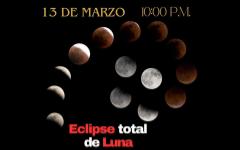
In the context of International Women's Day, Adriana Gazol Patiño, a researcher at the Institute of Radio Astronomy and Astrophysics, at UNAM Campus Morelia, received the Sor Juana Inés de la Cruz Recognition, given by UNAM to outstanding academics.

On March 13 and 14 we will observe a “red Moon,” as a total lunar eclipse is popularly known. Throughout Mexico, we will observe our natural satellite passing through the shadow of the Earth for several hours, so it will first darken and then light up with slightly reddish, orange or copper colors.

March 8 is International Women's Day. This date reminds us of the necessary and daily struggle that the entire community has to undertake for a future with equality and justice.

The Moon will tinge with reddish colors on the night of March 13-14 this year, as we observe a total lunar eclipse throughout Mexico. For several hours, our natural satellite will pass through the shadow of the Earth, so it will first darken and then light up with slightly reddish, orange or copper colors.

What do we really see in a pretty image of the universe? The colorful images of nebulas that we see on social media, such as those taken by the James Webb or Hubble space telescopes, give us a lot of information about what happens in those regions of space, in addition to being aesthetically beautiful.




